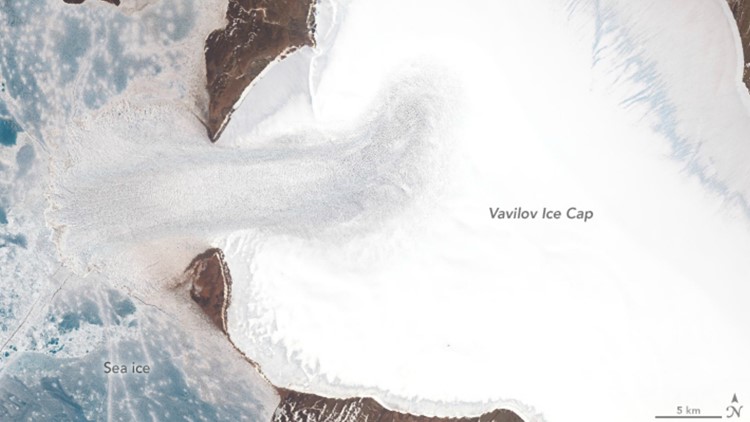A glacier that once moved 20 meters (65.6 feet) per year is now moving that fast every day, according to a post on a NASA-run U.S. government website. And, some estimate it could be racing even more quickly.
NASA's Earth Observatory claims a cold-based glacier in the Russian High Arctic has been sliding "at a breakneck pace" since 2013 -- a phenomenon the space agency says "mystified" University of Colorado Boulder glaciologist Michael Willis. The publication says after decades of moving slowly, the outlet glacier of Vavilov Ice Cap began creeping forward into the Kara Sea at a modest pace between 2000 and 2013. But, it has since accelerated.
Willis was the lead author of a paper published in November 2018 that suggested the glacier is now moving as fast as 82 feet per day.
The shift became highly-publicized in a recent article by Ron Brackett, a former editor for the Tampa Bay Times and current writer for The Weather Channel, which explained cold-based glaciers generally only move a few yards each year, making this situation unique.
According to the Earth Observatory, the glacier's ice shelf had more than doubled by 2018, and the ice on land has become much thinner -- especially around the edges.
“The fact that an apparently stable, cold-based glacier suddenly went from moving 20 meters per year to 20 meters per day was extremely unusual, perhaps unprecedented,” Willis told NASA. “The numbers here are simply nuts. Before this happened, as far as I knew, cold-based glaciers simply didn’t do that...couldn’t do that.”
Science and technology website Gizmodo and magazine Popular Science both sounded the alarm on the situation in the fall of 2018. In fact, Popular Science described the glacier as "surging" as quickly as 82 feet per day as far back as 2015. Gizmodo explained the glacier is situated in a polar desert with cold temperatures and dry weather that should be keeping it "firmly tethered to the underlying bedrock." But, it's not.
NASA says the glacier's pace slowed slightly in 2018 but sped back up again in 2019. Willis told the Earth Observatory the ice cap has thinned enough for snow to stop accumulating on its upper reaches. Now, his team is trying to figure out the cause. The Earth Observatory says the group's current theory is that water probably found its way under the land-based part of the glacier -- lessening friction and causing the quick slide, which was only hastened by slippery sediments, possibly containing clay, just offshore.
“This event has forced us to rethink how cold-based glaciers work,” Willis told NASA. “It may be that they can respond more quickly to warming climate or changes at their bases than we have thought.”
What other people are reading right now:
►Make it easy to keep up-to-date with more stories like this. Download the 10News app now.
Have a news tip? Email desk@wtsp.com, or visit our Facebook page or Twitter feed.



